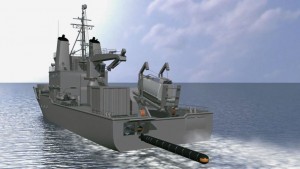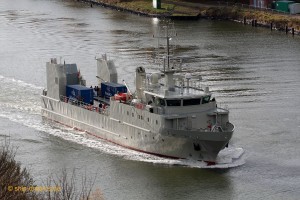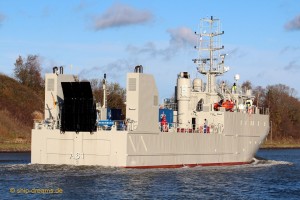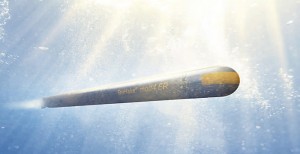SHAH ALAM: Even with the two Perdana Menteri class submarines, the RMN ASW capabilities remained limited with only the upcoming LCS having proper submarine hunting suites . With a limited SLEP for the Lekiu class and none for the Kedah class, RMN will be facing a future without much ASW capabilities.
The proposed funding for four MPAs in RMK11 might boost the maritime domain awareness (whatever that means!), a limited budget might forced the ASW suite off the planes.
It is for this reason I read with deep interest a Janes report (I will only post articles which relates to Malaysia) about UAE acquiring highly capable ASW vessels.


“The United Arab Emirates (UAE) is probably operating innocuous-looking vessels that are armed with the world’s longest-range torpedo: a capability that would enable it to target Iranian Kilo-class submarines at their base.
Confirmation that the UAE has received new torpedo systems came in the form of the defence export report that the German government released in June. It stated that two “floating platform[s] with torpedo-launching gear” had been exported to the UAE in 2014, along with underwater detection equipment.”
The vessels UAE acquired is the Rmah class, described by the Janes report as floating platforms. Based on information on the Internet this two support vessels are 58 metres long, about the same size of our current FACs. Since the RMN is looking to replace its FAC fleet, the ASW capability offered by these innocuous vessels certainly out-trump the Daewoo contender.


If the Janes report is correct, we could also get similar capabilities from such vessels. The same hull could also be adapted to a more versatile patrol boat armed with a 30mm gun in the A position while behind the bridge, VLS and SSM launchers could be installed. The stern launcher for the Seahake Mod4 ER torpedoes could be maintained. As it is there is no need for a dedicated stern launcher as the torpedo could also be launched from special containers.


The two UAE vessels apparently have its smoke stacks at the stern but this could move forward for our vessel. I am no naval architect but I believe the front of the hull could be made longer to accommodate our much more unforgiving seas compared to the Persian Gulf.


Anyhow there is no need for us to follow the UAE in building the same vessel, we could also get a 75 metre FAC, one fitted for specially to fire Seahake Mod4 ER torpedoes, from the stern or containers.
These torpedoes have a range of 140km, even better than most heavyweight torpedoes fired from submarines. Most lightweight torpedoes fired from surface warships ranges from 23km (low speed) and 10km (high speed).
These torpedoes are also a good replacement for the Blackshark heavy weight torpedo arming the Perdana Menteri class submarines.
We could still hope the Seahake has been selected for the LCS as the type of the torpedo has not been announced. However as Atlas Elektronik have not taken part in either LIMA or DSA exhibitions the chance of it being chosen for the LCS is rather low.
Of course there are many variables to a successful ASW operations, having a ship with a capable weapon system is just the start. But that is the least we can offer to our sailors.
— Malaysian Defence
If you like this post, buy me an espresso. Paypal Payment
View Comments (63)
The UAE faces the same situation as we do, as in most of its waters are relatively shallow. In many parts of the Melaka Straits and even the fringes of the South China Sea, subs can often be spotted clearly from the air. It is common to see USN boats on the surface in the Melaka and Singapore Straits as the waters are too shallow to dive!
We have to bear in mind that not only do we lack ASW gear but that most ships are not fitted with torpedo decoys (a situation which admittedly applies to many other navies as well).
Most people are focused on missiles (being sexier) but in any future conflict a ship is probably likelier to be attacked by a torpedo or even a mine that costs RM100,000!
The problem with ASW is that it's very cash and resource intensive; very expensive to learn and very expensive to maintain the skills. Once lost or eroded; the skills are hard to re-acquire; a situation many NATO navies learnt in the post Cold War period. With regards to ASW gear, one solution would be the STN Atlas modular ASW system that can retrofitted to almost any ship. Same thing goes with mine hunting gear.
There is next to zero chance of a future RMAF MPA being fitted with sonarbuoys, torpedoes and MAD as this would significantly drive up the overall cost of the programme. It will also be expensive to maintain the gear and to train the people to operate it.
The next few years will be interesting as navies will be using drones at bases to detect the presence of subs and divers. Which brings to mind, what happened to the underwater surveillance system. that was supposed to have been bought for Sepanggar?
Even as standalone systems the hull mounted sonars on the Lekiu and Kasturi are pretty decent. Together with the hull mounted and towed array sonar on the LCS and ASW configured helos (not yet ordered off course), the RMN will have a decent ASW capability for a navy it's size and with its budget.
Reply
The Sepanggar USS tender remained under evaluation.
Its a blunder when the kedah class didnt get their SLEP. Just install a sonar system like thales bluewatcher + thales captas 1, they will be quite good. Then install torpedo tubes. Then adding anti-air system like the planned rim-116 or searam and anti-surface with kda nsm. The ships will become quite potent.
But then again its like wishing for a 'durian runtuh' in our current situation.
"..having a ship with a capable weapon system is just the start. But that is the least we can offer to our sailors"
Absolutely. Estimates put the number of subs in service with the navies in the Indo-Pacific at circa 120 boats. ASW capability should be the next step in RMN's repertoire. I also think that they need to work closely with RMAF on ASW as it's part of the Maritime domain. Also, in the era of austerity and jointery, I don't see why RMAF MPA planes can't be jointly run with RMN -- think budgets -- and partially crewed by trained RMN pilots/air crew.
Submarines are scary. They make sea denial achievable at relatively low cost. We can see that in the Falklands War. The action of a single sub (Conqueror) on an enemy cruiser (Belgrano) resulted in the Argentine navy, including its aircraft carrier (Skyhawks embarked) limiting itself to shallow waters, greatly reducing the threat to the UK Task Force.
It's interesting that UAE Navy doesn't operate subs at the moment but has acquired ASW capability. It's difficult to get info on the Rmah-class ship but a website says the Atlas torpedo's range has been tested up to 75nmi.
I don't see any risk from enemy submarines. All the risk in Malaysia is presently internal and paradoxically from the apparatus of government. When you have the DPM going on about 'dignity', there is a huge problem.
Ferret,
The ideal situation would be for MPAs to the owned, flown and maintained by the RMAF but be under the operational control of the RMN. Off course the RMAF would then argue that the budget should come from the RMN.
@ marhalim
Look at the uae boat. No way at all it could be modified into a "FAC". There is no way that kind of Hull shape could be anything but "Fast".
Basically it is a hull based commercial oil and gas supply vessels. A slow ship fitted with equipment to listen to and destroy submarines (remember silent running diesel electric submarines does not sail underwater at speed)
A very interesting concept that could well be adapted to malaysia. It would be a good additional hull for normal eez patrols, "show of presence" missions in addition to its primary ASW mission. But to look at it as a "FAC"? I don't think so.
Reply
You are right perhaps it's better to call it a patrol boat.
Azlan,
Sure, that's one way to look at it and it may well work fine.
My opinion is there are three, no, four 'domains' that should be joint: heli trg, development of amphibious forces, SF and maritime patrols, including fixed wing ASW. Maritime patrols (air and sea assets) are going to become more and more important in the years ahead.
From reading their in-house rag, the Joint HQ or the 'Purple Force' as they like to call themselves, seem to be a happy bunch so a joint 'Maritime Command' for example should work operations- and C2-wise. Detaching an RMAF sqn under command of RMN may pose problems -- presence of air liaison officers not withstanding -- not least of which is lack of understanding of technical issues, such as what the planes can and cannot do, maintenance, trg, and so on.
More than happy to hear your thoughts on this.
Ferret,
You raise good points. Perhaps also a ''Joint UAV Command'' [assuming we ever get UAVs in decent numbers]?
Ideally, the sensor operators on the MAP would be RMN, with the RMAF only in charge of flying and maintaining the MPA. Overall control would be with the RMN but various issues have to be sorted out force, primarily with regards to operational expenses and stuff like that. The RSN/RSAF has a similar arrangement with their Fokkers. If the RMAF had it's way it would happily hand over the MPA role to the RMN; just like how it has been wanting to hand over the troop/utility rotary role to the army.
In our context, doing what I've proposed it's easier said than done as although ''jointness'' has significantly improved, there's still a lot of room for improvement [the same also goes for others] with regards to mindset, parochialism, turf guarding, etc.
Reply
We going backwards on joint-ness however. Empire building is more important....
Lots of such vessels were built during WWII, most well known being the Flower class. These were built in yards with small slipways and used simple triple expansion machinery rather than turbines.
The were relatively slow but that was not that much of an issue as the convoys they guarded were even slower.
High speed and subhunting are mutually exclusive. You really see this in the USN LCS which is pathetic in the role.
A more useful vessel is really a large cutter or sloop type vessel, shared with Maritim, built to commercial standards which can serve as depot ship to small craft and have a heli-deck for vertrep and running UAVs.
The Danish Standard Flex is a good idea but I just don't see us being able to break free from the French influence.
The Knud Rasmussen OPV would be a good example. Base crew of only 18.